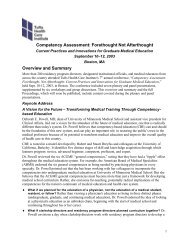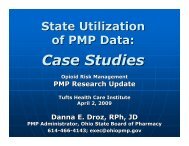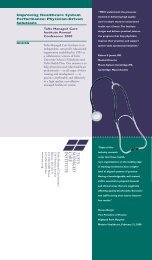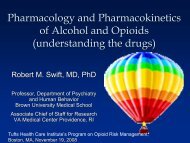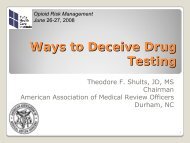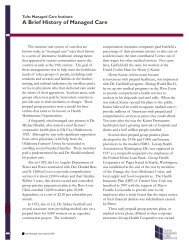Presentation
Presentation
Presentation
You also want an ePaper? Increase the reach of your titles
YUMPU automatically turns print PDFs into web optimized ePapers that Google loves.
Opioid Risk Management<br />
The Role of Prescription Monitoring<br />
March 29, 2005<br />
Grant M. Carrow, Ph.D.<br />
Deputy Director<br />
Center for Quality Assurance and Control<br />
Massachusetts Department of Public Health
Objectives<br />
• What are the goals of PMPs<br />
• What is the current status of PMPs<br />
• What initiatives is the MA PMP<br />
undertaking<br />
• What are some future issues for PMPs
Prescription Monitoring<br />
• A tool for use in addressing prescription<br />
drug diversion<br />
• Prescription data collected from<br />
dispensers<br />
• Data reviewed and analyzed by state<br />
agency<br />
• Reports provided to authorized end users
Goals of PMPs<br />
• Education and information<br />
• Public health initiatives<br />
• Early intervention and prevention<br />
• Investigations and enforcement<br />
• Protection of confidentiality<br />
Source: Alliance of States with Prescription Monitoring<br />
Programs
Goals of PMPs: : Education and<br />
Information<br />
• General information for practitioners,<br />
pharmacists and the public<br />
• Analysis of prescribing and dispensing trends<br />
• Specific information and feedback for<br />
practitioners and pharmacists<br />
• Assist practitioners and pharmacists in identifying<br />
forgeries and illicitly obtained prescriptions<br />
• General awareness of drug diversion<br />
Source: Alliance of States with Prescription Monitoring<br />
Programs
Goals of PMPs: : Public Health<br />
Initiatives<br />
• Development of policies<br />
• Under- and over- utilization<br />
• Inappropriate prescribing<br />
• Initiation of education and prevention programs<br />
• Targeting programs to subpopulations<br />
• Formulation of laws and regulations<br />
• Establishment of practice and treatment<br />
guidelines<br />
Source: Alliance of States with Prescription Monitoring<br />
Programs
Goals of PMPs: : Early<br />
Intervention and Prevention<br />
• Early detection of drug diversion<br />
• Scams, doctor shopping, forgeries<br />
• Deterrent effect<br />
• General knowledge of tracking mechanism<br />
• Serialized or tamper-evident evident prescription forms<br />
Source: Alliance of States with Prescription Monitoring<br />
Programs
Goals of PMPs: : Investigations<br />
and Enforcement<br />
• Assist in identifying and investigating potential<br />
drug diversion<br />
• Increase efficiency of investigations<br />
• Collection of evidence<br />
• Responding to complaints<br />
• Minimize disruption to practitioners and<br />
pharmacists<br />
• Early identification of invalid complaints<br />
Source: Alliance of States with Prescription Monitoring<br />
Programs
Goals of PMPs: : Protection of<br />
Confidentiality<br />
• Restrictions on access to monitoring data<br />
• Protection of practitioner, pharmacist and patient<br />
privacy<br />
Source: Alliance of States with Prescription Monitoring<br />
Programs
Uses of PMP Data<br />
Public Health/Medicine/Research<br />
Law Enforcement<br />
Regulatory
Rx Monitoring States<br />
State<br />
Year Enacted<br />
CALIFORNIA 1939<br />
HAWAII 1943<br />
ILLINOIS 1961<br />
IDAHO 1967<br />
NEW YORK 1972<br />
RHODE ISLAND 1978<br />
TEXAS 1981<br />
WASHINGTON 1984<br />
INDIANA 1987<br />
MICHIGAN 1988<br />
OKLAHOMA 1990<br />
MASSACHUSETTS 1992<br />
NEVADA 1995<br />
UTAH 1995<br />
WEST VIRGINIA 1995<br />
KENTUCKY 1998<br />
TENNESSEE 2002<br />
VIRGINIA 2002<br />
MAINE 2003<br />
PENNSYLVANIA 2003<br />
WYOMING 2003
Rx Monitoring States<br />
Category<br />
Number 1<br />
% U.S. Total<br />
States 19 38%<br />
Census 145,312,288 52%<br />
Practitioners 498,720 52%<br />
Midlevel 45,634 50%<br />
Retail Pharmacies 29,905 49%<br />
1<br />
excluding states with limited programs (VA, WA)<br />
Sources: U.S. Census Bureau, 4/2/01; U.S. Drug Enforcement Administration, 11/12/03
State Rank by Population<br />
Census<br />
Rank<br />
State<br />
Census<br />
1 California 33,871,648<br />
2 Texas 20,851,820<br />
3 New York 18,976,457<br />
4 Florida 15,982,378<br />
5 Illinois 12,419,293<br />
6 Pennsylvania 12,281,054<br />
7 Ohio 11,353,140<br />
8 Michigan 9,938,444<br />
9 New Jersey 8,414,350<br />
10 Georgia 8,186,453<br />
11 North Carolina 8,049,313<br />
12 Virginia 7,078,515<br />
13 Massachusetts 6,349,097<br />
14 Indiana 6,080,485<br />
15 Washington 5,894,121<br />
Source: US Census Bureau,4/2/01
State Rank by Population<br />
Registered Practitioners<br />
Rank<br />
State<br />
Practitioners<br />
1 California 119, 689<br />
2 New York 78,068<br />
3 Texas 57, 655<br />
4 Florida 53,163<br />
5 Pennsylvania 46,050<br />
6 Illinois 40,305<br />
7 Ohio 36,054<br />
8 New Jersey 34,045<br />
9 Michigan 32,423<br />
10 Massachusetts 28,522<br />
11 North Carolina 24,420<br />
12 Virginia 24,008<br />
13 Georgia 23,843<br />
14 Maryland 22,474<br />
15 Washington 21, 647<br />
Source: US Drug Enforcement Administration, 11/12/03
Rank<br />
Metropolitan Area Ranking<br />
by Population<br />
Metropolitan Area<br />
Census<br />
1<br />
New York—Northern New Jersey—Long Island, NY—<br />
NJ—CT<br />
CT—PA CMSA<br />
21,199,865<br />
2 Los Angeles—Riverside<br />
Riverside—Orange County, CA CMAS 16,373,645<br />
3 Chicago—Gary<br />
Gary—Kenosha, IL—IN<br />
IN—WI CMAS 9,157,540<br />
4 Washington—Baltimore, DC—MD<br />
MD—VA—WV CMSA 7,608,070<br />
5 San Francisco—Oakland<br />
Oakland—San Jose, CA CMSA 7, 039,362<br />
6 Philadelphia—Wilmington<br />
Wilmington—Atlantic City, PA—NJ<br />
NJ—<br />
DE—MD CMSA<br />
6,188,463<br />
7 Boston—Worcester<br />
Worcester—Lawrence, MA—NH<br />
NH—ME—CT<br />
CMSA<br />
5,819,100<br />
8 Detroit—AnnArbor<br />
AnnArbor—Flint, MI CMSA 5,456,428<br />
9 Dallas—Fort Worth, TX CMSA 5,221,801<br />
10 Houston—Galveston<br />
Galveston—Brazoria, TX CMSA 4,669,571<br />
Source: US Census Bureau,4/2/01
Rx Monitoring States<br />
Doctor Shopping Reports for Practitioners<br />
State<br />
Upon Request<br />
Without Request<br />
Idaho <br />
Kentucky<br />
<br />
Nevada <br />
Texas<br />
<br />
Utah <br />
Source: Alliance of States with Prescription Monitoring Programs
MA PMP Overview<br />
• Established in 1992 by joint regulation of the Drug<br />
Control Program (105 CMR 700.000) and Board<br />
of Registration in Pharmacy (247 CMR 5.00)<br />
• Collects data on Schedule II prescriptions<br />
dispensed by community, clinic and outpatient<br />
pharmacies<br />
• 2.4 million CII prescriptions monitored in FY 04<br />
• 93 prescription monitoring cases in FY 04
MA PMP Milestones<br />
• 1982: Efforts to establish PMP initiated by DPH<br />
• 1987: U.S. DOJ grant to DPH<br />
• 1991: Efforts initiated to establish electronic PMP<br />
• 1992: Joint DPH/BRP regulations promulgated<br />
• 1993: Funding by Legislature; MRGs formed<br />
• 1994: First cases approved by MRGs;<br />
glutethimide initiative<br />
• 1995: Practitioner survey<br />
• 2003: U.S. DOJ grant to DPH
Practitioner Survey:<br />
Participant Demographics<br />
Specialty %<br />
Pediatrics 31%<br />
Internal Medicine 21%<br />
Family Practice 9%<br />
Surgery 7%<br />
Oncology 4%<br />
Emergency Trauma 4%<br />
Neurology 4%<br />
Ob/Gyn 3%<br />
Pain Management 2%<br />
Child Psychiatry 1%<br />
Anesthesiology 1%<br />
Radiology 0%<br />
Other 14%<br />
TOTAL 100%<br />
n=1057<br />
Source: Massachusetts Department of Public Health and Brandeis University
Practitioner Survey:<br />
Numbers of Prescriptions<br />
Written<br />
Schedule II Rx/mo.<br />
Mean ± S.E.<br />
Opioid analgesics 17 ± 0.9<br />
Stimulants 15 ± 1.0<br />
Sedatives 3 ± 0.4<br />
All 29 ± 1.3<br />
Source: Massachusetts Department of Public Health and Brandeis University
Extent of Public Health Problem<br />
any diversion<br />
doctor shopping (non-medical)<br />
Mode of Diversion<br />
doctor shopping (medical)<br />
patient pressure<br />
criminal distribution<br />
Rx forgeries<br />
HCP diversion<br />
0% 10% 20% 30% 40% 50% 60% 70% 80% 90% 100%<br />
Percent of Respondents<br />
large<br />
moderate<br />
slight<br />
insignificant
0<br />
50<br />
45<br />
40<br />
35<br />
30<br />
25<br />
20<br />
15<br />
10<br />
5<br />
Number of Prescriptions<br />
Jan-94<br />
Feb-94<br />
Mar-94<br />
Apr-94<br />
May-94<br />
Jun-94<br />
Jul-94<br />
Aug-94<br />
Sep-94<br />
Oct-94<br />
Nov-94<br />
Dec-94<br />
Jan-95<br />
Feb-95<br />
Jun-95<br />
May-95<br />
Apr-95<br />
Mar-95<br />
Glutethimide Prescriptions (1994-1995)<br />
Month
MA PMP Enhancement<br />
Project
MA PMP Enhancement<br />
Project<br />
Harold Rogers Prescription Monitoring Program<br />
• FFY 2002 U.S. Department of Justice Appropriations<br />
Act (Public Law 107-77)<br />
77)<br />
• U.S. Department of Justice<br />
• Office of Justice Programs<br />
• Bureau of Justice Assistance<br />
• U.S. Drug Enforcement Administration<br />
• FFY 2003 award to MA: $220,000<br />
• FFY 2004 award to MA: $350,000
MA PMP Enhancement<br />
Project<br />
Project Goal<br />
• Reduce the impact of prescription drug<br />
diversion and abuse in Massachusetts by<br />
optimizing utilization of the PMP
MA PMP Enhancement<br />
Project<br />
Project Objectives<br />
• Improve analysis of PMP data to more<br />
efficiently and accurately identify cases<br />
needing investigation<br />
• Improve access to and utilization of PMP<br />
findings by law enforcement and regulatory<br />
agencies<br />
• Engage prescribers and healthcare<br />
community in use of PMP data to address<br />
prescription drug abuse, addiction and<br />
diversion
MA PMP Enhancement<br />
Project<br />
Analytical and Technological<br />
Enhancements<br />
1. Automation of manual algorithms<br />
2. Development of epidemiologic tracking<br />
system<br />
3. Development of prototype data access<br />
system
Future Issues for PMPs<br />
• Enhanced utilization of PMP data<br />
• Best practice guidelines<br />
• Interstate interoperability<br />
• Coordination/consolidation of multiple<br />
databases<br />
• Integration with electronic prescribing
www.mass.gov/dph



